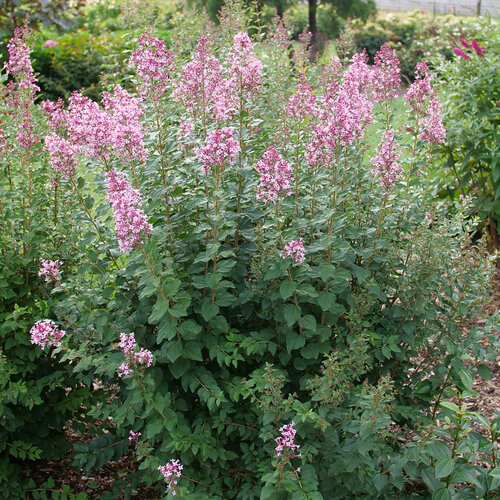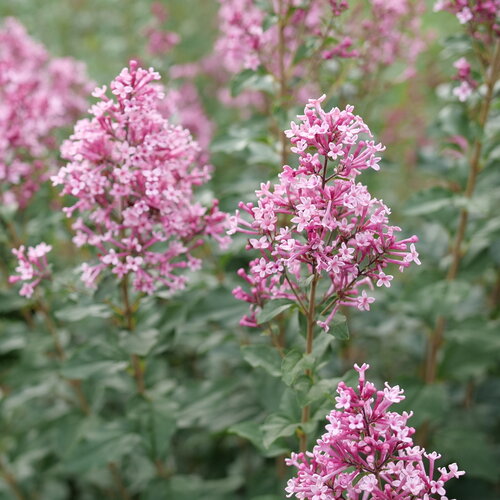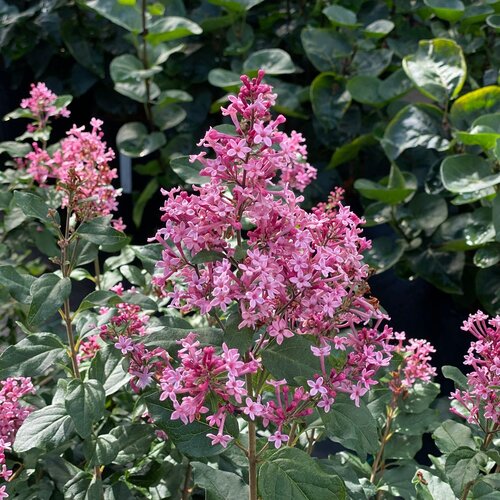Bloomerang Ballet® Reblooming Lilac Syringa
- Sun
- Spring
- Summer
- Fall
-
Details
36 - 48 Inches36 - 48 Inches36 - 48 Inches91cm - 1.2m91cm - 1.2m91cm - 1.2mFeatures
Like a real ballerina, Bloomerang Ballet® lilac puts on a dainty looking show with incredible strength and dedication. It puts out an abundance of frilly pink blooms in the spring, has a brief intermission in early summer, and a gorgeous rebloom performance from late summer into fall. It’s our strongest rebloomer yet! Thanks to good disease resistance, you’ll get to enjoy its foliage as well as its flowers. A great candidate for cut flower gardens, as it blends well with other stems or makes a lovely single species arrangement.
Top reasons to grow Bloomerang Ballet lilac?
- Strong reblooming ability
- Lovely pink coloring
- Great disease resistance
Fragrant FlowerContinuous Bloom or RebloomerDisease ResistantLong BloomingFall InterestAttracts:BeesButterfliesResists:DeerSmall or MiniatureCharacteristics
Plant Type:ShrubShrub Type:DeciduousHeight Category:MediumGarden Height:36 - 48 Inches 91cm - 1.2mSpacing:36 - 48 Inches 91cm - 1.2mSpread:36 - 48 Inches 91cm - 1.2mFlower Colors:PinkFlower Shade:Medium pinkFoliage Colors:GreenFoliage Shade:GreenHabit:UprightContainer Role:ThrillerPlant Needs
Light Requirement:SunThe optimum amount of sun or shade each plant needs to thrive: Full Sun (6+ hours), Part Sun (4-6 hours), Full Shade (up to 4 hours).
Maintenance Category:ModerateBlooms On:New WoodBlooms On:Old WoodBloom Time:SummerBloom Time:SpringBloom Time:FallHardiness Zones:3a, 3b, 4a, 4b, 5a, 5b, 6a, 6b, 7a, 7bWater Category:AverageNeeds Good DrainageSoil PH Category:Alkaline SoilSoil PH Category:Neutral SoilUses:Border PlantUses:ContainerUses:Cut FlowerUses:LandscapeUses:Mass PlantingUses Notes:A classic addition to foundation plantings and mixed borders. Bloomerang lilac is also a popular choice for planting in decorative containers - learn more here.
Maintenance Notes:Plant only in full sun and well-drained soil; lilacs cannot tolerate soggy, wet conditions.
The rebloom of Bloomerang lilac occurs on the new growth the plant creates after its spring bloom. For the best rebloom, it's vital that the plant grows vigorously during late spring and early summer. Do this by keeping it well-watered and mulched and in plenty of sun (six hours a day at least). If you wish to fertilize it, you may do so in early spring, once the ground has thawed, and again in late spring, after it blooms.
If you want to prune Bloomerang lilac, do so immediately after its spring bloom. Never cut it back in fall, winter, or early spring - doing so will remove the spring flower buds. It is not necessary to prune Bloomerang lilac in order for it to rebloom. However, giving it a light trim after blooming does remove the developing seed heads (they look like green bananas, and some people don't care for the way they look on the plant), providing a neater look, and encourages more new growth for reblooming. Trimming after blooming will delay the rebloom by a few weeks compared to an untrimmed Bloomerang lilac.
Like nearly all lilacs, Bloomerang lilac actually requires a period of cold weather in order to bloom well. This is why lilacs are not typically suited to warmer climates. However, they are very, very cold tolerant and thrive in climates as cold as USDA zone 3.
Fun Facts:The botanical name of lilac, Syringa (suh-RIN-gah), is from the Greek word syrinx, which means tube. This is because the stems of lilac contain a spongy pith which can be remove, leaving a hollow tube that has traditionally been used to create pan-pipes.
Bloomerang Ballet® Syringa 'SMNSPH' USPP 35,934, Can PBRAF










